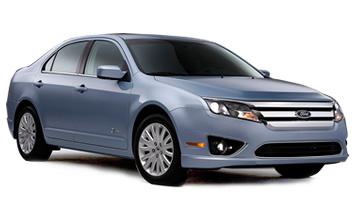-
MATERIAL ISSUES
- Materiality Analysis
-
Climate Change
- Climate Change: Related Commitments and Progress
- Greenhouse Gas Emissions Overview
- Climate Change Risks and Opportunities
- Our Strategy: Blueprint for Sustainability
-
Ford's Sustainable Technologies and Alternative Fuels Plan
- Improving Fuel Economy
- Migration to Alternative Fuels and Powertrains
- Ford's Green Partnerships with the Federal and State Governments
- Progress and Performance
- Climate Change Policy and Partnerships
- Electrification: A Closer Look
- Mobility
- Human Rights
- Vehicle Safety
- Sustaining Ford
- Perspectives on Sustainability
Toolbox
Migration to Alternative Fuels and Powertrains
In This Section

Hybrid Electric Vehicles (HEVs)
Ford Fusion
Ford currently offers four hybrid models in the United States. By 2013, we will offer seven hybrid models in the United States and Europe.
| 2007 | 2011 | 2020– 2030 |
|---|---|---|
NEAR TERM Begin migration to advanced technology |
MID TERM Full implementation of known technology |
LONG TERM Continue deploying advanced powertrains and alternative fuels and energy sources |
Hybrid Electric Vehicles (HEVs) |
||
In 2004, Ford introduced the world's first hybrid SUV, the Ford Escape Hybrid. We followed up with the Mercury Mariner Hybrid in 2005. In early 2009 we further expanded our hybrid vehicle lineup by introducing the Ford Fusion and Mercury Milan Hybrids. All of these vehicles are full parallel hybrids, meaning they can run exclusively on battery power, exclusively on gas power or on a combination of both to deliver the best overall energy or fuel efficiency. As of early 2010, we had produced more than 125,000 hybrids worldwide. We are currently increasing our hybrid volume, targeting a cost reduction of more than 30 percent in our 2012 next-generation hybrid systems and preparing for hybrid capability across our highest-volume global product platforms.
The Ford Fusion Hybrid has an Environmental Protection Agency fuel economy rating of 41/36 mpg city/highway, making it the most fuel-efficient midsize sedan in the United States today.1 The Fusion Hybrid's fuel economy significantly exceeds that of its nearest midsize sedan competitor, and it can go more than 700 miles on a single tank of fuel. It includes an innovative new SmartGauge™ with EcoGuide instrument cluster that coaches hybrid drivers to maximize fuel efficiency. With the Fusion and Milan Hybrids, we doubled the number and volume of our hybrid lineup in the United States.
In 2010, we will launch the Lincoln MKZ Hybrid, which is expected to be the most fuel-efficient luxury sedan in America. In 2012 we plan to deliver our next-generation hybrid vehicles, including a hybrid based on a compact or "C-car" platform. The next-generation system, already under development, will be even more efficient and more cost-effective than the current system and will use lithium-ion battery cells. All of Ford's electrified products, including hybrids, plug-in hybrids and battery electric vehicles, will use lithium-ion battery cells by 2012.
As part of our global electrification plan, we will extend our hybrid vehicle technology to Europe. By 2013, we plan to introduce two next-generation hybrid vehicles and a plug-in hybrid in Europe. The European HEVs will be based on our global "C-car" platform and our "CD-car" (or midsize) sedan. The European PHEV will be based on the all-new C-MAX, a derivative of our global "C-car" platform.